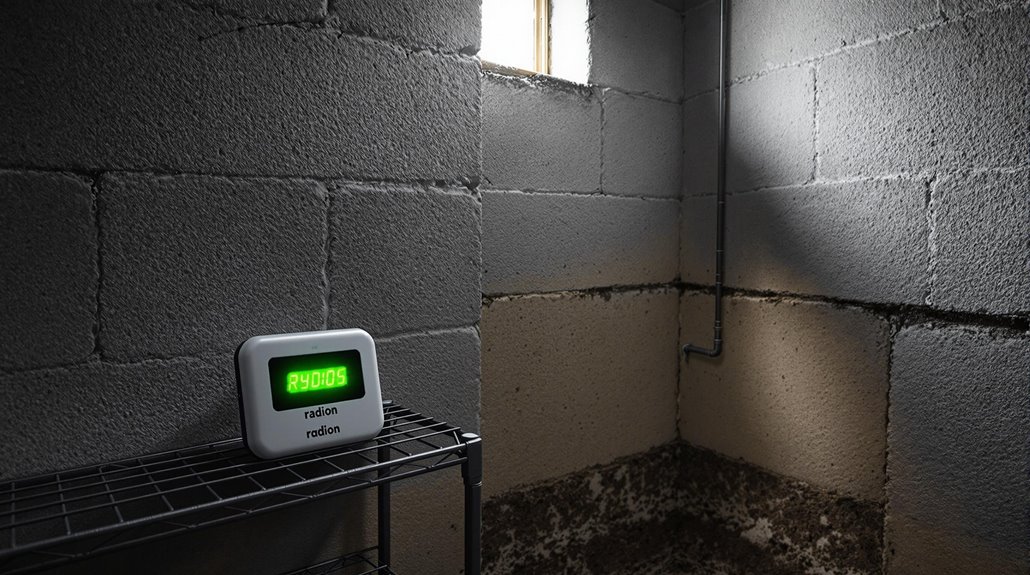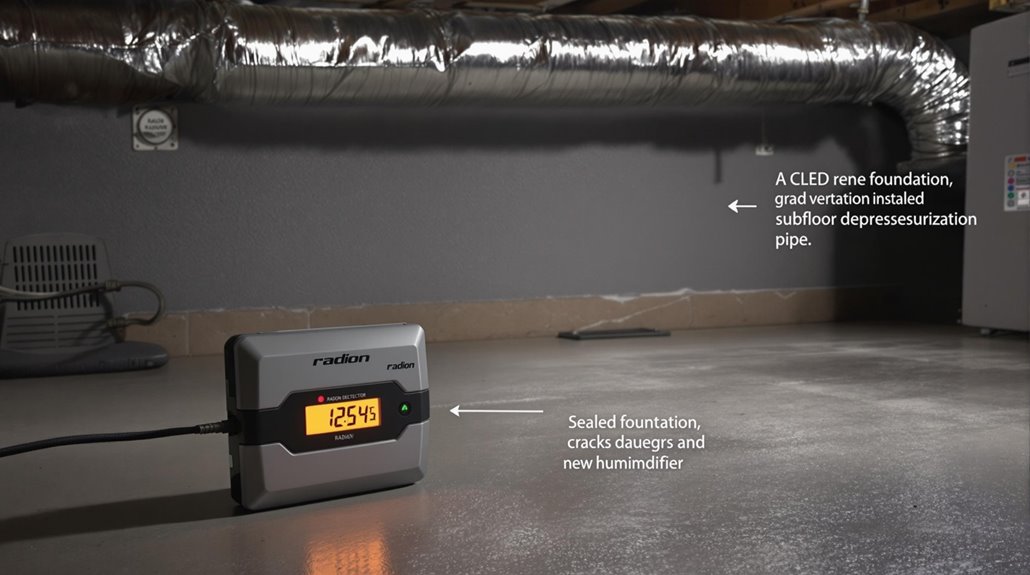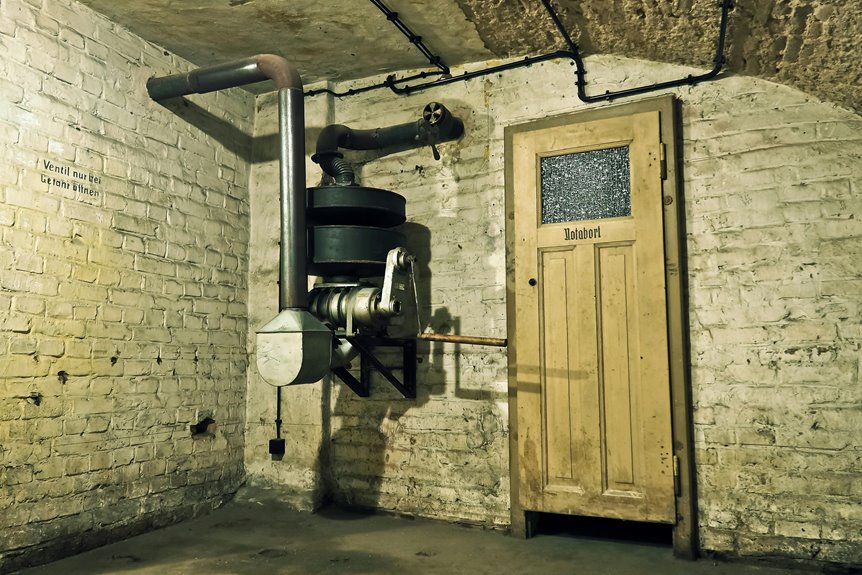Your basement could be harboring dangerous levels of radioactive radon gas, a leading cause of lung cancer that claims 21,000 lives annually. This invisible threat seeps through foundation cracks and poorly sealed openings, with one in fifteen homes containing hazardous concentrations. You’ll need professional testing ($150-$300) or DIY kits ($15-$35) to assess your risk level, while mitigation systems can reduce exposure by up to 99%. Understanding your home’s vulnerability is just the beginning of protecting your family’s health.
What Is Radon and Where Does It Come From?

Radon, a naturally occurring radioactive gas, emerges as an invisible menace in homes across America. It’s formed by the natural breakdown of uranium in soil, rock, and water – a process that’s been happening beneath our feet for millions of years.
You’ll find radon sources concentrated in areas with specific geological factors, including granite deposits and phosphate-rich soils. The gas seeps upward through foundation cracks and enters your home through various entry points: floor drains, construction joints, and even your water supply.
You’re most vulnerable if you live in regions with uranium-rich bedrock. What’s particularly troubling is how this odorless killer can accumulate to dangerous levels in your basement while you remain completely unaware.
The EPA estimates that radon causes 21,000 lung cancer deaths annually – more than drunk driving fatalities.
Health Risks Associated With Radon Exposure
When radioactive particles enter your lungs through radon exposure, they begin their deadly work at the cellular level. These particles damage your lung tissue, creating microscopic injuries that can lead to cancer.
You won’t notice immediate health effects – there are no exposure symptoms to warn you of the invisible threat lurking in your basement.
The statistics are shocking: radon causes more than 21,000 lung cancer deaths annually in the U.S., making it the second leading cause of lung cancer after smoking. Your risk increases by 16% for every 100 Bq/m³ increase in radon concentration.
If you’ve lived in a home with elevated radon levels for years, you’re playing Russian roulette with your respiratory health. The EPA estimates that one in fifteen homes contains dangerous radon levels.
Testing Your Basement for Radon Levels
You’ve got two clear options for testing radon levels in your basement: hire a certified professional or purchase a do-it-yourself test kit that meets EPA standards.
While DIY kits cost between $15-$35 and can detect short-term exposure levels, professional testing provides more thorough data collection over time, typically ranging from $150-$300.
Your basement should be tested at least every two years, immediately after major renovations, or before a home sale – because this invisible killer won’t politely announce its presence while it accumulates in your living space.
Professional Testing Vs DIY
Deciding between professional radon testing and do-it-yourself options presents a vital choice that impacts your family’s health and financial planning.
While do-it-yourself testing kits cost between $15-30, professional services typically range from $150-800. The price difference seems stark, but consider the implications.
DIY tests can provide basic readings, but they’re prone to user error and may miss essential variations in radon levels.
Professional testing services employ certified technicians with calibrated equipment that continuously monitors levels over time, detecting patterns that single-use home tests can’t identify.
They’ll also position testing devices strategically throughout your basement, rather than relying on a single point of measurement.
Your choice here isn’t just about immediate costs – it’s about accuracy, reliability, and ultimately, your family’s long-term safety.
When to Test Radon
Timing plays a pivotal role in obtaining accurate radon measurements for your basement.
You’ll need to conduct radon testing during the coldest months, typically between November and March, when your home’s windows remain closed. Winter testing provides the most accurate readings of this radioactive gas’s presence, as it tends to accumulate more during these months.
Your testing frequency should align with key triggers: after major renovations, following natural disasters, or when buying/selling property.
The EPA recommends testing every two years, even if previous results were low. Don’t wait for symptoms – they won’t appear until years of exposure.
If you’ve recently sealed foundation cracks or installed a new HVAC system, schedule immediate testing.
Common Entry Points for Radon in Basements
Your basement’s foundation isn’t the impenetrable barrier you might expect, as radon gas can infiltrate through microscopic cracks and gaps that form over time due to settling, temperature changes, and water damage.
Damaged plumbing penetrations, where pipes enter your basement through the foundation, create vulnerabilities that allow this radioactive gas to seep directly into your living space.
These entry points, often hidden from casual inspection, can transform your basement into a collection point for radon concentrations that exceed EPA safety thresholds by 400% or more.
Cracks and Foundation Gaps
Three major pathways allow radon to infiltrate basements through foundation flaws – cracks in concrete walls and floors, gaps around service pipes, and poorly sealed sump pump openings.
These defects create direct channels for this radioactive gas to seep into your living space, putting your family at risk.
You’ll find that hairline cracks as small as 1/32 inch can let radon slip through, while larger foundation gaps become superhighways for contamination.
Professional crack sealing isn’t just cosmetic – it’s essential protection against this invisible threat.
When foundation repair costs average $4,500, some homeowners delay fixes, unaware that radon levels can spike 400% through untreated openings.
Don’t wait for warning signs; there aren’t any.
Your basement’s structural imperfections are literally creating a welcome mat for this cancer-causing gas.
Damaged Plumbing Penetrations
While foundation cracks pose obvious risks, damaged plumbing penetrations create equally dangerous entry points for radon gas in your basement. You’ll find these vulnerabilities where pipes enter through your foundation walls and floor, often hidden from plain sight. Regular plumbing inspections can reveal these potential hazards before they become serious problems.
| Location | Risk Level | Signs to Look For | Action Needed | Cost Range |
|---|---|---|---|---|
| Pipe Entries | High | Visible gaps | Immediate sealing | $100-300 |
| Floor Drains | Critical | Cracks around drain | Professional repair | $200-500 |
| Sump Pumps | Severe | Loose fittings | Seal and test | $150-400 |
| Utility Lines | High | Deteriorated caulk | Replace sealant | $50-200 |
| Water Heater | Moderate | Corrosion | Inspect yearly | $75-250 |
Don’t ignore these potential entry points. Professional sealing gaps around plumbing penetrations can greatly reduce radon infiltration.
Effective Radon Mitigation Methods
Several proven methods can effectively reduce dangerous radon levels in your home’s basement.
You’ll find both passive and active systems available, with active systems providing superior results through powered ventilation. A sub-slab depressurization system, the most effective solution, uses PVC piping and an extraction fan to pull radon from beneath your foundation before it enters living spaces.
For immediate action, you can seal foundation cracks, install specialized membranes, and improve basement ventilation.
Active systems typically reduce radon levels by 99%, while passive systems achieve a 50% reduction.
You’ll need to invest $800 to $2,500 for professional installation, but considering radon causes 21,000 lung cancer deaths annually, it’s a small price for your family’s safety.
Regular testing guarantees your chosen method maintains effectiveness.
Long-Term Prevention Strategies

Implementing long-term radon prevention strategies before construction can save homeowners thousands in future mitigation costs.
You’ll want to focus on incorporating passive sub-slab ventilation systems during the initial building phase, which can reduce radon levels by up to 50% before they become a problem. Smart builders now include these systems as standard practice, not a luxury add-on.
Your second line of defense involves thorough sealing techniques.
You’ll need to properly seal foundation cracks, utility penetrations, and sump pump openings – areas where radon commonly enters. Don’t forget to install a vapor barrier beneath the concrete slab.
These methods, when combined with proper ventilation, create a formidable defense against radon infiltration. Industry data shows preventive measures cost 70% less than post-construction fixes.
Working With Radon Mitigation Professionals
Because your family’s safety hangs in the balance, selecting a qualified radon mitigation professional requires careful vetting and due diligence. When researching radon specialists, you’ll need to verify their credentials, experience, and track record of successful installations.
- Request proof of state certification and membership in professional organizations like the American Association of Radon Scientists and Technologists.
- Ask for at least three references from previous clients who’ve had mitigation systems installed within the past year.
- Obtain detailed written proposals that outline system design, installation timeline, and warranty terms.
Don’t let contractors pressure you into immediate decisions. Reputable professionals understand the importance of thorough evaluation and will welcome your questions.
Conclusion
You’re not powerless against this invisible invader lurking beneath your feet. With proper testing and mitigation, you can transform your basement from a potential health hazard into a safe haven for your family. Don’t let radon’s silent threat continue unchecked – take action today. Remember, your home’s foundation shouldn’t be a gateway for danger, but rather your first line of defense against this radioactive intruder.





